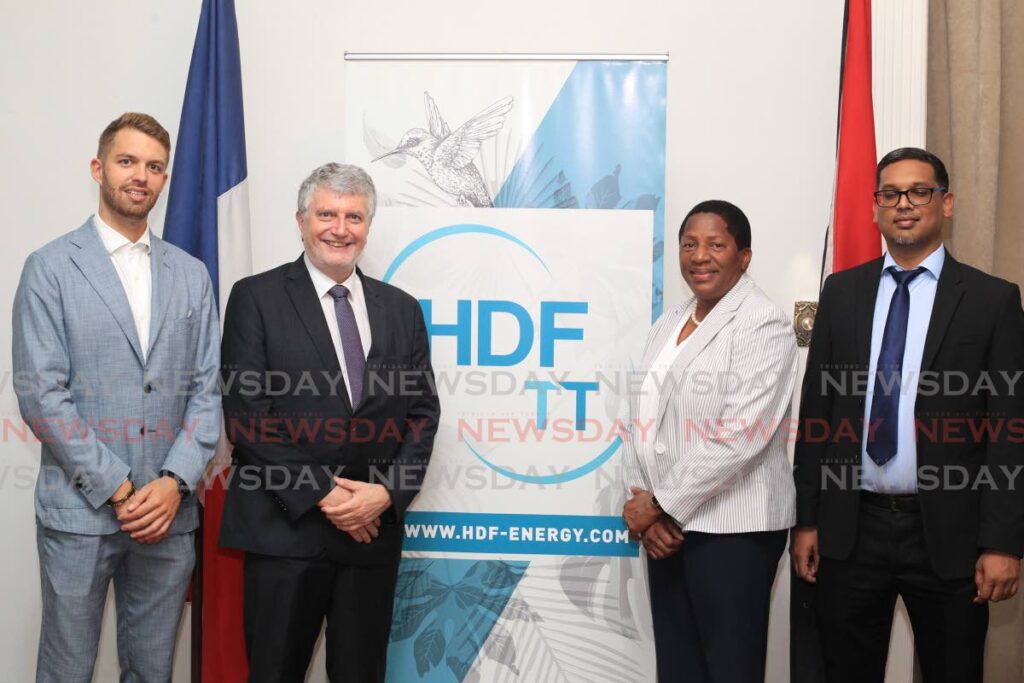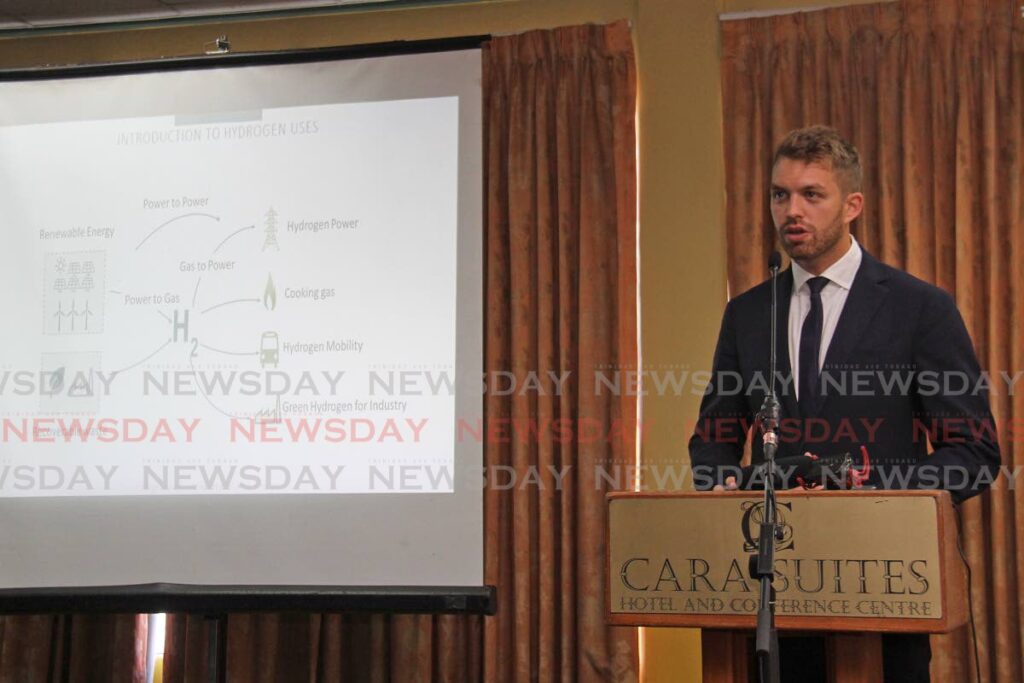HDF set to take lead in green hydrogen in Trinidad and Tobago

If you are waiting in line to dance with the most beautiful girl at a ball or a dance, would you want to be the second person to dance with her – or do you want to be first?
If you are training for a big race or a competition, are you practising to come in second place, or do you want to be first?
If you own a business in a lucrative but competitive field, would you rather be ranked second in the world, or do you want to be first?
There's nothing wrong with second place, but let’s face it – being first is better.
TT has a history of being first, especially when it comes to energy and energy industries in the Caribbean. The first commercial oil well was drilled in TT, in what is now called Point Fortin, in 1907. In the mid-1950s the Energy Chamber, then called the South Trinidad Chamber of Industry and Commerce, was formed and also was the first of its kind – with a focus on energy and energy industries.
Now with the demand for fossil fuels reaching its peak and steadily declining
and the world looking toward hydrogen as the fuel of the future, TT has an opportunity once again to be first in line in energy in the region, with the help of Hydrogen De France (HDF), which recently launched its local branch, HDF TT, to begin projects in TT.
But the window of opportunity to be first in line yet again is closing fast, and with it the window of opportunity for financing clean-energy projects which could help with TT’s transition away from fossil fuels.
In a conversation with vice president of HDF Thiabault Ménage and director of HDF TT Dale Ramlakhan, Business Day was told the opportunities given through the establishment of HDF TT should be taken seriously – or that window will close and TT will be left behind.
Be first or fall behind
HDF TT was launched last Thursday, the way for the newborn company to begin its first of many local hydrogen projects. It acquired 70 per cent of Kenesjay Green Ltd's NewGen project. When completed, the project, estimated at more than US$200 million, will result in the construction of a clean hydrogen producing electrolysis facility – the largest of its kind in the world.
At a cocktail reception at the French Embassy on Mary Street in Port of Spain that day, Ménage said TT is poised to take the lead in the hydrogen industry in the region.
“The Point Lisas estate is looking for more hydrogen,” Ménage said. “It is short of 400,000 tonnes of hydrogen, which is not being provided at the moment.
"There is a very urgent need for using TT assets at their maximum capacity. Because it is already a hydrogen hub TT has everything to become a world leader in this area.”
Ramlakhan told Business Day in a conversation last Friday that its close cluster of plants makes TT perfect for developing facilities centred around energy transition. He added that TT also has an advantage because there is a market for its petrochemical products, which are used as feedstock for producing fertiliser and manufacturing plastics, pesticides, dyes and other chemicals.
“We have methanol plants next to ammonia plants, next to steel plants, next to gas and power infrastructure,” he said. “We have a lot of benefits that we can extract from the existing elements that would make this project work.”
HDF TT, in its business strategy, plans to use project financing to deliver the project. Project financing allows for capital expenditure intensive projects to be financed with a high portion of debt and therefore makes it more competitive.
“In this case, what the project has to do is show that it has the strength of contracts for the supply of power and off take of hydrogen and with this lenders would say that it is a sound contract, there is little chance that people would renege on the contract and they would finance the project,” Ramlakhan said.

But if TT does not act quickly, opportunities for financing that would come out of being first will go to other countries.
“Hydrogen is now a buzzword,” Ramlakhan said. “The European energy plan going forward heavily features hydrogen. The US plan also features hydrogen.
"But they are taking the approach in terms of grants to support the development of equipment, to support developers, to support subsidising the cost of production so that it gets off the ground.”
“If we miss the opportunity, all the production of equipment, all the developers, all the capital for these projects will go into these markets, and we could struggle to attract investors. You will have to play catch-up. If we lose that over time to these other projects, there is no guarantee that we will recapture these markets.”
Green fuel of the future
Although hydrogen as a fuel is clean and could be considered the fuel of the future, about 96 per cent of the world’s hydrogen is made through the use of fossil fuels.
In most cases hydrogen is acquired through steam-methane reforming, which uses high-temperature steam to produce hydrogen from natural gas. In this method the methane reacts with steam under high pressure in the presence of a catalyst to produce hydrogen, carbon monoxide and carbon dioxide.
In TT, at Point Lisas, plants which produce ammonia and methanol use natural gas to break apart the molecules and separate the hydrogen from other carbon molecules.
HDF, a hydrogen production and storage company at its core, uses a process called electrolysis to acquire hydrogen. This process uses water as the source material instead of fossil fuels to generate its hydrogen content.
“That is what the electrolyser does, it uses electricity to split the water molecules into hydrogen and oxygen,” Ramlakhan said.
Coming from a water source which has little to no carbon footprint, green hydrogen is considered “clean,” with only a small percentage of CO2 per kilogramme of hydrogen produced.
Ménage explained that HDF usually uses a hydrogen-to-power module which accrues hydrogen for generating clean power and storage for a steady supply of electricity. This module is being used in an HDF facility in French Guiana. The project uses a combination of solar power and hydrogen fuel cells to deliver a consistent and clean electricity source for power grids.
Solar energy generates electricity during the day, and some of that electricity is stored in hydrogen fuels cells to be used at night. This way, the power grid is decarbonised, but does not have any intermittency problems.
“The project in French Guiana is the first of its kind worldwide. It is the largest green-hydrogen storage in the world under construction, and it is the first hydrogen project financed through project financing,” Ménage said in a conversation with Business Day last Friday. “This model, we are duplicating it in every part of the world. There is one in Namibia and there will be an even more advanced one in Barbados.”
For the NewGen project, HDF TT would be embarking on another first in its application of the green, clean hydrogen. Ramlakhan said HDF TT’s NewGen project would be focusing on a “hydrogen to (X)” module – in this case, “X” would be an industrial application.
The NewGen project will use a combination of solar and energy-efficient power sources to generate carbon-free hydrogen to meet about 20 per cent of the hydrogen requirements of an ammonia plant in the petrochemical hub in Point Lisas.
HDF, with its expertise in developing hydrogen systems, will guide TT through the process of constructing the system, which would then supplement the usage of hydrogen downstream, in this case in ammonia plants, which use natural gas to create commodities. That additional supply of hydrogen would allow the ammonia plants to reduce the use of natural gas for hydrogen production, saving on natural gas and making the process that much cleaner.
Ramlakhan said TT also has the benefits of having excess capacity of electricity and a generation grid that could be modernised to make it more efficient, thus providing a source of electricity without having to increase natural gas.
He added that the project, when completed, would be the benchmark for many other countries on cleaner production of commodities
“This project is leading on quite a few fronts,” he said. “It is close to leading on being certified clean in terms of the low-carbon footprint and clean hydrogen, it is leading in the environmental process, it is close to leading in the technological aspects – so there is no comparison.”
“This project is going to be setting the example,” Ramlakhan added. “A lot of the contractors that we spoke to are interested in the project because it gives them the capacity to understand how to instal it and replicate it elsewhere. So traditionally we could try to compare it and ask what it would look like in other places; in this case, people would be looking at TT and saying, 'What does it look like in TT and how can we replicate it?'”
Hydrogen pioneers
Ménage described HDF not as a power company or a hydrogen supplier, but as hydrogen pioneers. Established in 2012, HDF, he said, is a project-developer of hydrogen infrastructure as well as a provider of hydrogen-based technology such as fuel cells.
“The market response for providing fuel cells at the speed that we need it for our project was simply not there,” he said. “So we decided to also become a technology provider for our own projects.
"It is a unique positioning. You don’t see that a lot on the market, being a developer and also a technology provider for a specific part of the project.”
Ménage said while HDF is passionate about clean energy and the benefits to the planet, it is also a private company which understands that it has to grow as a business to continue to have an impact on the world.
“In order for an entity such as ours to be attract the best talent, we need to be able to pay them as well. We need to be able to make money and grow and have more impact. So we have a realistic approach, but a pioneering one,” he said.
“If we have invested in NewGen, that means that we think it is profitable and competitive. The renewable and new green sector is large, but it is not as large as the oil and gas sector.
"But we are more aligned and coming from the renewable-energy world. A lot of our expertise comes from the renewable-energy world. Hydrogen is potentially the oil of the future.
"We are not losing track of what makes a company profitable, but we are passionate about what we do.”
Companies such as HDF and HDF TT are showing they have the know-how and the technology to transition the TT energy sector and poise it to lead the industries of the future, with its own innovation and an interest in investing in TT. As a nation we now have to ask ourselves: are we satisfied with playing catch-up in clean-energy industries, or do we want to be first?

Comments
"HDF set to take lead in green hydrogen in Trinidad and Tobago"